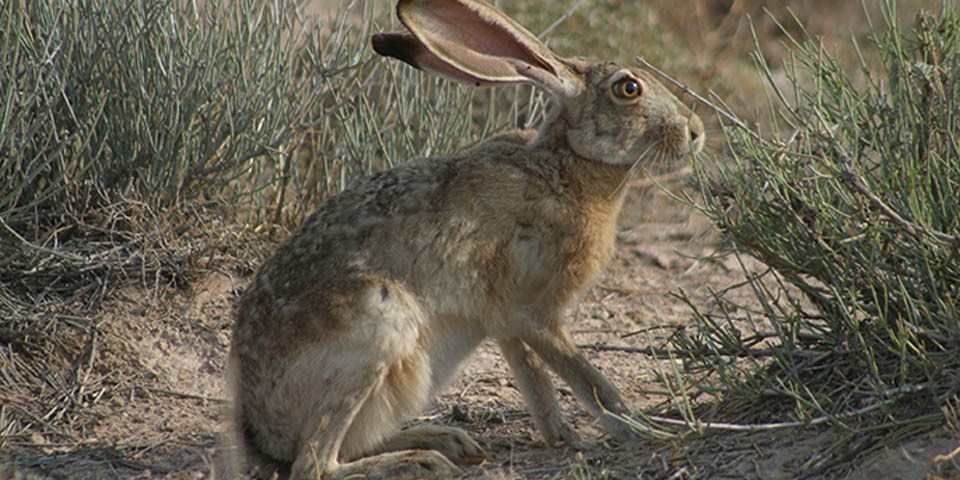
Doug Burkett, Senior Scientist, ECO-Inc. Photo Picture a desert in the middle of the summer. The sun is glaring overhead, and heat rises in waves above the sandy soil. Below the sparse, scrubby brush, a common desert resident rests, half-hidden in the shade. By day, this furry, long-eared animal spends most of his time dozing off, but at night, he comes alive, bounding across the sand as he forages for the plants and vegetation he eats. Can you guess who this desert resident is? It’s the black-tailed jackrabbit (Lepus californicus)! Found throughout the southwestern US and into parts of Mexico, this small, gray-brown mammal is named for the black stripe along the top of its tail. You can also identify black-tailed jackrabbits by their large, long, black-tipped ears. Out here in the desert, these long ears have two uses. They not only give the jackrabbit keen hearing, but they also allow the jackrabbit to regulate its body temperature. How? Well, those big ears are full of blood vessels. When the jackrabbit gets too hot, these blood vessels widen, which promotes heat loss. Certainly a useful adaptation for hot desert days! While the black-tailed jackrabbit does indeed have a black tail, the other part of its name is a misnomer. Despite being called a rabbit, this long-eared animal is actually a hare! What’s the difference? Although hares and rabbits look similar, with small tails, big ears, and oversized hind feet, hares are a little leaner and may also grow larger. The black-tailed jackrabbit can grow up to two feet long (about 60cm) and weigh between three and eight pounds (1.4-3.5 kg), which is bigger than the desert cottontail rabbits also found at White Sands. The most significant difference between rabbits and hares, however, is their offspring. Rabbits build nests to house their bald, blind, helpless babies. Hares, on the other hand, don’t build nests for their young. Their babies (called leverets) are born with fur, open eyes, and can follow along after their mother shortly after birth. Despite this difference, rabbit and hare reproduction is similar in sheer quantity—both have large numbers of offspring. A female black-tailed jackrabbit can have anywhere from two to six litters a year, with one to six leverets per litter. When these babies grow and start reproducing, the jackrabbit numbers quickly swell. This exponential population growth from reproduction helps balance out population loss from predation. Coyotes, foxes, bobcats, badgers, large snakes, and large birds of prey (e.g., eagles, hawks, etc.) all eat black-tailed jackrabbits. If they can catch them, that is. Black-tailed jackrabbits are fast, bounding away from danger and running in zigzag patterns at speeds up to 40 miles (64 km) per hour! Their speed has even earned them a place in folk tales—just think of “The Tortoise and the Hare!” Predators can’t keep up. Unfortunately, the jackrabbit can’t keep up this speed for long, and crafty coyotes may take advantage of this by switching off during the chase. Still, if it comes down to a footrace for survival, the black-tailed jackrabbit has a good chance of winning. Because the black-tailed jackrabbit is such a good runner, it prefers habitats with lots of space for running, like open, arid areas with sparse vegetation. These are places like desert scrublands, sand dunes, prairies, overgrazed rangeland, and, of course, White Sands National Park. Here at the park, black-tailed jackrabbits live on the edges of the dunefield, where the dunes meet the desert. They’re typically not active during the heat of the day, so you’re not likely to see them. However, if you’re lucky, you may spot some tracks in the sand. |
Last updated: August 22, 2020
